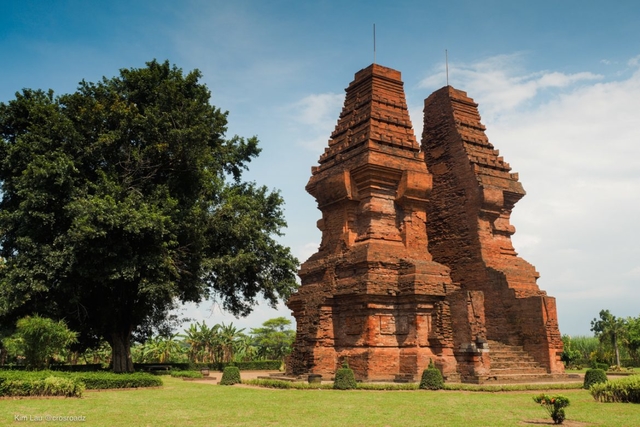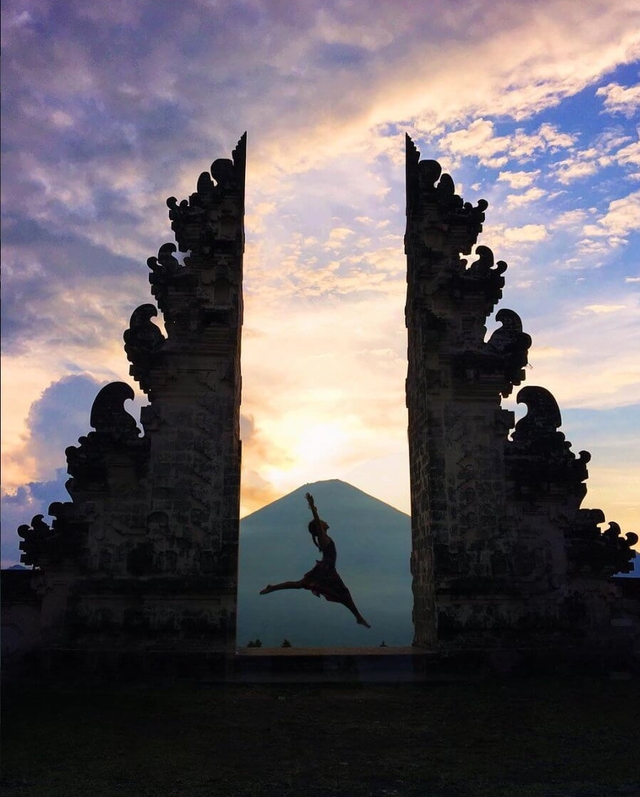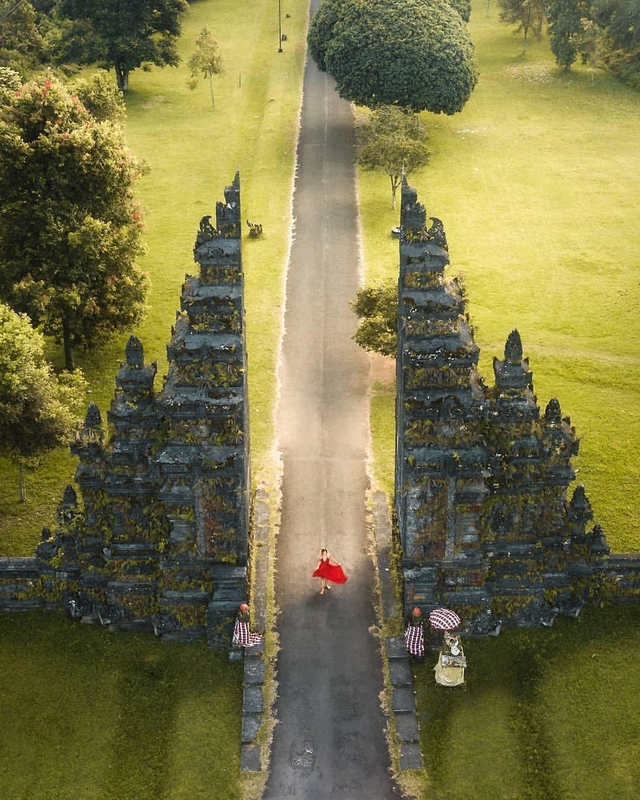
The split gates, known as "Candi Bentar," are one of the most classic visual symbols of Bali.
Candi Bentar gates are usually found at the entrances to religious structures, royal palaces, or cemeteries. However, in recent times, more secular places incorporate Candi Bentar into their architecture. A notable example is the entrance gate to the beach in Kuta or the gates of the Bali Handara golf resort.
Candi Bentar consists of symmetrical gates shaped like the silhouette of a Balinese temple, divided in the middle. To pass through them, one typically needs to climb a few steps. Such gates are not exclusive to Bali; they are also found in Java, where the Majapahit dynasty once brought culture to Bali, and on Lombok.
There are several styles of Candi Bentar, from simple and smooth ones made of red brick in the Majapahit dynasty style in Cirebon, Demak on Java, to plaster-covered sliding gates in the Kaybon palace in Banten, Surakarta, and Yogyakarta, also on Java. Richly decorated gates are also present in Balinese temples and palaces.

Candi Bentar serves no defensive purpose; originally, they were designed without doors.
The symbolism of these gates is explained in various ways.
According to some versions, these gates resemble the sacred Mount Meru, which was split into two equal parts. Meru is a mythological mountain where the gods reside, appearing not only in Hindu mythology but also in Jain and Buddhist stories.
According to other interpretations, both sides of the split gates represent the Balinese concept of duality and the importance of maintaining balance between dark and light forces.
Some cultural experts believe that Candi Bentar serves purely aesthetic purposes, creating a sense of grandeur before entering the temple.
Candi Bentar gates (without upper lintels or arches) and Paduraksa gates (arch-shaped with doors) are essential components of Balinese and Javanese temples.
Both types of gates delineate spaces with varying degrees of sacredness within the temple. Candi Bentar typically marks the boundary between the external world and the outer courtyard of a Balinese temple (nistha mandala).
Paduraksa usually serves as the boundary between the middle courtyard of the temple (madia mandala) and the innermost, most sacred courtyard (utama mandala).

In Balinese temples, numerous rituals take place, and Candi Bentar gates often serve as a colorful backdrop for ceremonies and sacred dances. Some of the more sacred dances occur in the inner courtyard of the temple, making the Paduraksa gates a visual focal point during majestic ceremonies.
The tradition of creating Candi Bentar gates is believed to have originated around the 13th-14th centuries during the Hindu period of the Javanese Vedic dynasties of Singhasari and Majapahit.
The oldest Candi Bentar gates still in existence were discovered by archaeologists in Trowulan, the ancient capital of the Majapahit dynasty. They were named Vringin Lavang, or "banyan wood gates."

The spread of Candi Bentar was associated with the aesthetic influence of the Majapahit dynasty on Javanese and Balinese architecture.
Even after the spread of Islam in Java, Candi Bentar gates continued to be used. The Menara Kudus Mosque, dating back to the 16th century and one of the oldest mosques in Java, still incorporates Candi Bentar, marking the entrance to the mosque complex. The Sendang Duwur Muslim cemetery complex in East Java contains both Candi Bentar and Paduraksa.

In contemporary times, the construction of Candi Bentar is encouraged by the Indonesian government as a form of regional identity. The government of Banten province in Java promotes the construction of Candi Bentar gates, following the example of the gates of the Kaybon palace, especially those located along the main road.
In Cirebon, West Java, red-brick Candi Bentar gates have become the signature style of the city.
Candi Bentar gates also mark the entrances to various civic buildings, including those erected at the Soekarno-Hatta International Airport in Jakarta.
The number of Candi Bentar gates in Bali is countless, but among them, some are particularly majestic, intricately decorated, and beloved by tourists.
1. Lempuyang Temple (Pura Lempuyang)

Lempuyang Temple - one of the most popular spots among Instagrammers visiting the island. If you want to capture yourself at these gates, be prepared to wait in line for several hours.
The highlight of these gates is the view of Mount Agung, visible between the halves of the Candi Bentar in clear weather.
By the way, if you don't necessarily need a view of Agung but simply appreciate the aesthetic of the gates, you can bypass them from the back and photograph them from below without waiting in line.
2. Bali Handara Golf Club (Bali Handara Gate)

The gates mark the entrance to the mountain golf resort. Previously, anyone could come here freely and for free. However, after the gates gained Instagram popularity, a manager was assigned to collect money for photography.
3. Besakih Temple (Pura Besakih)

Besakih Temple is considered the main Hindu sanctuary on the island. The Candi Bentar gates here are very unusual and unlike any other in shape.
4. Kuta Beach

This beach is the most crowded and popular on the island. Thousands of tourists pass through it every day.
The Candi Bentar gates look particularly impressive against the backdrop of the blue expanse of the ocean and the waves raging in the distance.
You can add one right now!